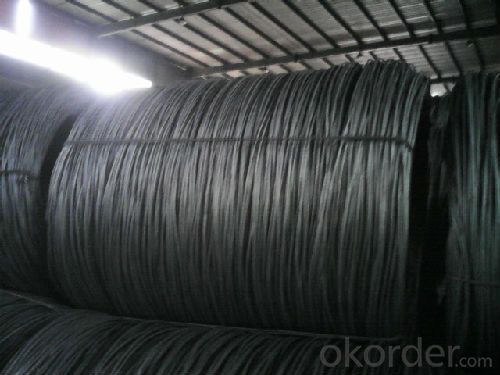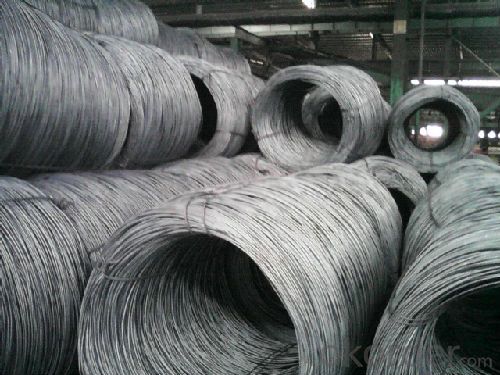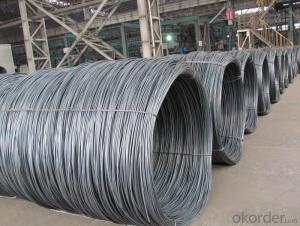Structure Steel Rod SAE1008B Steel Rod in Coils
- Loading Port:
- Tianjin
- Payment Terms:
- TT OR LC
- Min Order Qty:
- 30 m.t.
- Supply Capability:
- 20000 m.t./month
OKorder Service Pledge
OKorder Financial Service
You Might Also Like
Item specifice
Usage and Applications for Structure Steel Rod SAE1008B Steel Rod in Coils
The products are widely used in construction and manufacturing, mainly for reinforcement of reinforced concrete and
welded structure or reprocessed (roberts , nail, etc.) materials, especially used to produce wire drawing, welding
electrode, nails, spring, electronic, precise machinery parts and so on.
Specification for Structure Steel Rod SAE1008B Steel Rod in Coils
Steel Grade: Q195/235, SAE1006-1018B
Standard: ASTM, GB
Diameter: 5.5mm, 6.5mm, 7mm,8mm,9mm,10mm,12mm,14mm
Type: in coil, coil weight around 2MT
Alloy or Not: Alloy
Technique: Hot Rolled
Place of Origin: China Mainland
Surface: round, no twisted, light and smooth
Chemical Composition for Structure Steel Rod SAE1008B Steel Rod in Coils
Grade | Chemical Composition(%) | |||||
C | Mn | Si | S | P | B | |
SAE1006B | 0.03~O.07 | ≤0.32 | ≤0.30 | ≤0.045 | ≤0.040 | >0.0008 |
Mechanical properties | ||||||
Yield strength(N/mm2) | Tensile strength(N/mm2) | Elongation(%) | ||||
250-280 | 350-380 | ≥32 | ||||
Packaging and delivery for Structure Steel Rod SAE1008B Steel Rod in Coils
Packaging Detail: products are packed in coil, each coil weight around 2 MT, and then shipped by container or bulk vessel
Delivery Detail: within 45 days after received deposit or LC.
Label: to be specified by customer, generally, each bundle has 1-2 labels
Images for Structure Steel Rod SAE1008B Steel Rod in Coils



FAQ:
Q1: Why buy Materials & Equipment from OKorder.com?
A1: All products offered byOKorder.com are carefully selected from China's most reliable manufacturing enterprises. Through its ISO certifications, OKorder.com adheres to the highest standards and a commitment to supply chain safety and customer satisfaction.
Q2: How do we guarantee the quality of our products?
A2: We have established an advanced quality management system which conducts strict quality tests at every step, from raw materials to the final product. At the same time, we provide extensive follow-up service assurances as required.
Q3: How soon can we receive the product after purchase?
A3: Within three days of placing an order, we will begin production. The specific shipping date is dependent upon international and government factors, but is typically 7 to 10 workdays.
- Q:What are the major innovations in steel wire rod production technology?
- Steel wire rod production technology has undergone several significant advancements in recent years, greatly enhancing the efficiency, quality, and sustainability of the production process. One notable innovation is the adoption of continuous casting technology. In the past, steel wire rods were produced using a batch process, where molten steel was poured into individual molds and allowed to solidify before being cut into rods. However, continuous casting enables a continuous flow of molten steel to solidify into long strands. This eliminates the need for individual molds and increases the speed and productivity of production. Another important advancement is the utilization of high-speed rolling mills. These mills are equipped with advanced technologies that allow for faster rolling speeds and higher production rates. By using high-speed rolling mills, the output of steel wire rods can be increased, while also improving the quality and consistency of the final product. Moreover, the development of automation and digital technologies has revolutionized steel wire rod production. Automated systems and robotics now control various stages of the production process, from raw material handling to finished product packaging. This reduces the risk of human error and enhances overall efficiency and productivity. Furthermore, there have been significant advancements in metallurgy, resulting in the production of stronger and more durable steel wire rods. Manufacturers can now produce rods with superior mechanical properties, such as higher tensile strength and improved resistance to corrosion and fatigue, through the use of advanced alloys and heat treatment processes. Lastly, there has been a growing emphasis on sustainability in steel wire rod production. The industry has made strides in energy-efficient technologies and waste reduction strategies, leading to significant improvements in environmental impact. Energy recovery systems and the incorporation of recycled materials in the production process have reduced energy consumption and minimized waste generation. In summary, major innovations in steel wire rod production technology encompass continuous casting, high-speed rolling mills, automation and digital technologies, advancements in metallurgy, and a heightened focus on sustainability. These innovations have not only enhanced the efficiency and quality of steel wire rod production but have also contributed to a more sustainable and environmentally friendly industry.
- Q:What are the main factors affecting the market research of steel wire rod?
- The main factors affecting the market research of steel wire rod include supply and demand dynamics, price fluctuations, technological advancements, industry regulations, and the impact of global economic conditions. Additionally, factors like raw material availability, competition from alternative materials, and changing consumer preferences also play a significant role in shaping the market research of steel wire rod.
- Q:How is steel wire rod classified based on its diameter?
- Steel wire rod is classified based on its diameter into various categories. The classification is typically done using a wire gauge system or by specifying the diameter directly in millimeters. The wire gauge system assigns a numerical value to different wire diameters, with higher numbers indicating thinner wires. For example, in the United States, the American Wire Gauge (AWG) system is commonly used. In this system, the thickest wire is assigned the gauge number 0000 (four zeros), while the thinnest wire has a gauge number of 40. Each gauge number corresponds to a specific diameter range. Alternatively, steel wire rod can also be classified based on its diameter in millimeters. This approach directly specifies the exact diameter of the wire rod, allowing for more precise classification. For example, a wire rod with a diameter of 5.5 mm would be classified as such. Both methods of classification provide a standardized way to categorize steel wire rod based on its diameter. This information is important for various industries that utilize steel wire rod, such as construction, automotive, and manufacturing, as it allows them to select the appropriate wire rod for their specific applications.
- Q:What are the main factors influencing the choice of steel wire rod manufacturer?
- There are several main factors that influence the choice of a steel wire rod manufacturer. These factors include: 1. Quality of the product: One of the primary factors influencing the choice of a steel wire rod manufacturer is the quality of the product they offer. Customers look for manufacturers that produce high-quality steel wire rods that meet their specific requirements and standards. This includes factors such as the strength, durability, and consistency of the wire rod. 2. Price: Price is another crucial factor that influences the choice of a steel wire rod manufacturer. Customers compare prices offered by different manufacturers and choose the one that provides the best value for money. However, it is important to consider the price in relation to the quality of the product and the overall service provided by the manufacturer. 3. Reliability and reputation: The reliability and reputation of a steel wire rod manufacturer play a significant role in the decision-making process. Customers prefer manufacturers with a proven track record of delivering high-quality products consistently and on time. Positive customer reviews, testimonials, and references from other trusted sources can greatly influence the choice of a manufacturer. 4. Production capacity and capabilities: The production capacity and capabilities of a steel wire rod manufacturer are important considerations for customers. Depending on their specific needs, customers may require a manufacturer that can produce large quantities of wire rods within a specified timeframe. Additionally, customers may also consider the manufacturer's ability to provide customized wire rod solutions or different variations of the product. 5. Technical expertise and support: Steel wire rod manufacturers with strong technical expertise and excellent customer support are often preferred by customers. Manufacturers that can provide technical guidance, assistance with product development, and after-sales support are seen as valuable partners in the steel wire rod purchasing process. 6. Environmental and sustainability practices: In recent years, environmental and sustainability practices have become increasingly important factors in the choice of a steel wire rod manufacturer. Customers look for manufacturers that prioritize sustainable production methods, minimize waste and emissions, and comply with environmental regulations. Overall, the main factors influencing the choice of a steel wire rod manufacturer are quality, price, reliability, production capacity, technical expertise, and environmental practices. Customers carefully evaluate these factors to ensure they select a manufacturer that can meet their specific requirements and provide a high-quality product and service.
- Q:What are the different types of wire drawing dies used for steel wire rod?
- Steel wire rod can be drawn using several types of wire drawing dies. These dies vary in their composition and characteristics. Here are the different types commonly used: 1. Single crystal natural diamond dies: These dies, made from a single crystal diamond, are renowned for their exceptional hardness and resistance to wear. They are suitable for drawing both high carbon steel wire rod and stainless steel wire rod. 2. Polycrystalline diamond (PCD) dies: PCD dies are crafted by bonding multiple small diamond crystals together. They offer good wear resistance and can be used for drawing steel wire rod with intermediate carbon content. 3. Tungsten carbide dies: Utilizing tungsten carbide, a tough and durable material, these dies are often employed for wire drawing. They can handle high carbon steel wire rod and are capable of withstanding high pressures and temperatures. 4. Natural diamond dies with carbide support: These dies possess a core made of natural diamond, providing excellent wear resistance, while a carbide support structure adds strength and stability. They are suitable for drawing steel wire rod with high carbon content. 5. PCD dies with carbide support: Similar to the previous type, these dies have a PCD core and a carbide support structure. They offer good wear resistance and are suitable for steel wire rod with intermediate carbon content. 6. Polycrystalline diamond composite (PDC) dies: PDC dies are manufactured by sintering diamond particles with a binder material. They are well-known for their high wear resistance and are commonly used for drawing steel wire rod with low to medium carbon content. Each type of wire drawing die possesses unique advantages and is suitable for specific applications, depending on the carbon content and other properties of the steel wire rod being drawn.
- Q:What are the chemical composition requirements for steel wire rod?
- The chemical composition requirements for steel wire rod generally include specific percentages of carbon, manganese, silicon, sulfur, and phosphorus. These requirements vary depending on the specific grade and intended use of the wire rod.
- Q:How is steel wire rod used in the manufacturing of wire forms for transportation vehicles?
- Steel wire rod is used in the manufacturing of wire forms for transportation vehicles as it provides strength, durability, and flexibility. It is commonly used to create various wire components such as springs, cables, and reinforcements, ensuring the structural integrity and safety of vehicles. The steel wire rod is shaped, bent, and formed into specific designs and sizes, allowing it to be utilized for various applications in transportation vehicles, such as seat frames, suspension systems, and safety features.
- Q:What are the common manufacturing defects found in steel wire rod?
- Some common manufacturing defects found in steel wire rods include surface cracks, internal voids, improper dimensional tolerances, uneven surface finish, and inconsistent mechanical properties.
- Q:What are the main factors affecting the market certifications of steel wire rod?
- The main factors affecting the market certifications of steel wire rod include the quality and consistency of the product, adherence to industry standards and regulations, compliance with environmental and safety requirements, and the reputation and credibility of the manufacturer. Additionally, market demand and competition, pricing, customer satisfaction, and the overall economic and political situation can also influence the market certifications of steel wire rod.
- Q:What are the common industry guidelines for steel wire rod professionals?
- The common industry guidelines for steel wire rod professionals include adhering to strict quality control measures, ensuring compliance with safety regulations, maintaining proper handling and storage practices, conducting regular inspections and tests, and keeping up with technological advancements in wire rod production and processing. Additionally, professionals are expected to prioritize customer satisfaction, foster strong communication and collaboration within the industry, and stay updated on market trends and industry standards.
1. Manufacturer Overview |
|
|---|---|
| Location | |
| Year Established | |
| Annual Output Value | |
| Main Markets | |
| Company Certifications | |
2. Manufacturer Certificates |
|
|---|---|
| a) Certification Name | |
| Range | |
| Reference | |
| Validity Period | |
3. Manufacturer Capability |
|
|---|---|
| a)Trade Capacity | |
| Nearest Port | |
| Export Percentage | |
| No.of Employees in Trade Department | |
| Language Spoken: | |
| b)Factory Information | |
| Factory Size: | |
| No. of Production Lines | |
| Contract Manufacturing | |
| Product Price Range | |
Send your message to us
Structure Steel Rod SAE1008B Steel Rod in Coils
- Loading Port:
- Tianjin
- Payment Terms:
- TT OR LC
- Min Order Qty:
- 30 m.t.
- Supply Capability:
- 20000 m.t./month
OKorder Service Pledge
OKorder Financial Service
Similar products
New products
Hot products
Related keywords




























